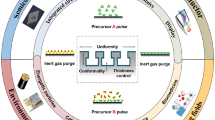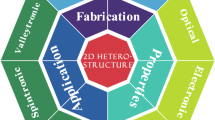Abstract
We fabricated and patterned magnetic dots from Co/Pt multilayers and optimized the structure for strong inter-dot magnetic coupling. SQUID measurements show strong perpendicular anisotropy with characteristic sheared hysteresis loops. The films are fabricated by RF-magnetron sputtering and then patterned with a 50 keV Ga+ focused ion beam (FIB) tool. This keeps surface roughness low and feature sizes in the hundred-nanometer-regime are achievable by a single processing step. Simulations with the well established SRIM (Stopping and Range of Ions in Matter) code give an estimation of the beam diameter and help to estimate the FIB patterning potential. In order to show antiferromagnetic ordering large 48×48 dot arrays of (200×200) nm2 single domain dots were fabricated. The samples were demagnetized and scanned by magnetic force microscopy (MFM) in the remanent state. The demagnetized checkerboard patterns show no frustration over hundreds of dots. The fabricated single domain magnets are prospective building blocks for field-coupled magnetic logic devices.
Similar content being viewed by others
References
A. Imre, G. Csaba, L. Ji, A. Orlov, G.H. Bernstein, and W. Porod : Majority Logic Gate for Magnetic Quantum-Dot Cellular Automata. SCIENCE, 311:205–208, January 2005.
G. Csaba, A. Imre, G. H. Bernstein, W. Porod, and V. Metlushko : Nanocomputing by Field-Coupled Nanomagnets. IEEE Transactions on Nanotechnology, 1(4):209–213, 2002.
P. F. Carcia, M. Reilly, Z. G. Li, and H. W. van Kesteren : Ar-Sputtered Pt/Co Multilayers with Large Anisotropy Energy and Coercivity. IEEE Transactions on Magnetics, 30(6):4395–4397, November 1994.
T. Aign, P. Meyer, S. Lemerle, J. P. Jamet, J. Ferre, V. Mathet, C. Chappert, J. Gierak, C. Vieu, F. Rousseaux, H. Launois, and H. Bernas : Magnetization Reversal in Arrays of Perpendicularly Magnetized Ultrathin Dots Coupled by Dipolar Interaction. Physical Review Letters, 81:5656–5659, 1998.
A. Thiaville, Belliard L., Majer D., E. Zeldov, and J. Miltat : Measurement of the stray field emanating from magnetic force microscope tips by Hall effect microsensors. Journal of Applied Physics, 82(7):3182–3191, October 1997.
W. B. Zeper, H. W. van Kesteren, B. A. J. Jacobs, J. H. M. Spruit, and P. F. Carcia : Hysteresis, microstructure, and magneto-optical recording in Co/Pt and Co/Pd multilayers. Journal of Applied Physics, 70(4):2264–2271, August 1991.
M. Becherer, G. Csaba, W. Porod, R. Emling, P. Lugli, D. Schmitt-Landsiedel : Magnetic Ordering of Focused-Ion-Beam Structured Cobalt-Platinum Dots for Field-Coupled Computing To be published in IEEE Transactions on Nanotechnology.
http://math.nist.gov/oommf/
J. F. Ziegler, J. P. Biersack, U. Littmark : The Stopping and Range of Ions in Solids. Vol.1 of series: Stopping and Ranges of Ions in Matter. Pergamon Press, New York, 1984.
Author information
Authors and Affiliations
Rights and permissions
About this article
Cite this article
Becherer, M., Csaba, G., Emling, R. et al. Focused ion beam structured Co/Pt multilayers for field-coupled magnetic computing. MRS Online Proceedings Library 998, 607 (2007). https://doi.org/10.1557/PROC-998-J06-07
Published:
DOI: https://doi.org/10.1557/PROC-998-J06-07




